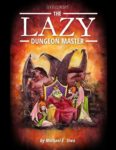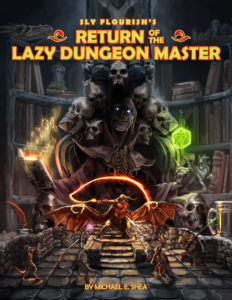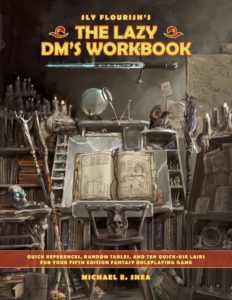The Lazy Dungeon Master (Tabletop RPG Book)
 As a big fan of the 80/20 method (80% of the results come from 20% of the effort) although I am want to abuse it and try to just do that 20% of the work and get 80% of the results. On a good day, I like to think I can even pull off a 10/90.. Well, running a role-playing campaign, especially one that isn’t just straight out of a book, is a daunting challenge. There are so many pitfalls and rabbit-holes to fall down that preparing for a session can suck up whatever time you have to spend. For several years, Michael Shea has run a blog giving advice on running an RPG campaign. Favoring the less if more approach, he’s covered topics like The Minimum Viable D&D Game or Running Combat in the Theater of the Mind. After a few years he put together a book called The Lazy Dungeon Master to package all of his advice into one book. Recently, he kickstarted a revised edition of the book as well as a companion workbook entitled Return of the Lazy Dungeon Master and The Lazy DM’s Workbook. He’s back again with a Kickstarter ending very soon, with The Lazy DM’s Companion. The new book is a mix of advice for specific types of situations (one on one games, zone based combat, creating secrets and clues, etc…) as well as a bunch of tables to help trigger new ideas and tools to help make a game more interesting while keeping things running smoothly. I thought I’d take a moment to give my thoughts on the first two books in the series.
As a big fan of the 80/20 method (80% of the results come from 20% of the effort) although I am want to abuse it and try to just do that 20% of the work and get 80% of the results. On a good day, I like to think I can even pull off a 10/90.. Well, running a role-playing campaign, especially one that isn’t just straight out of a book, is a daunting challenge. There are so many pitfalls and rabbit-holes to fall down that preparing for a session can suck up whatever time you have to spend. For several years, Michael Shea has run a blog giving advice on running an RPG campaign. Favoring the less if more approach, he’s covered topics like The Minimum Viable D&D Game or Running Combat in the Theater of the Mind. After a few years he put together a book called The Lazy Dungeon Master to package all of his advice into one book. Recently, he kickstarted a revised edition of the book as well as a companion workbook entitled Return of the Lazy Dungeon Master and The Lazy DM’s Workbook. He’s back again with a Kickstarter ending very soon, with The Lazy DM’s Companion. The new book is a mix of advice for specific types of situations (one on one games, zone based combat, creating secrets and clues, etc…) as well as a bunch of tables to help trigger new ideas and tools to help make a game more interesting while keeping things running smoothly. I thought I’d take a moment to give my thoughts on the first two books in the series.
The Return of the Lazy Dungeon Master
 While this book clearly has 5th Edition Dungeons and Dragons in mind, all its advice and suggestions are easily applicable to other systems and settings. One of the core components of this book is an eight-step process for preparing for a game. First, review the characters – take stock of who they are, what they want, and how the players like to play. Second, create a strong start – make sure whenever players sit down to a game they get pulled right into the story, whether that’s the beginning of the campaign or just the start of a night of play. (When in doubt, start with fight!) Third, outline potential scenes that might unfold, but be ready to toss them if the game does a different direction. Fourth, define some secrets and clues that one can leak into the story to give it more depth and set up events in the future – it’s best not to fix clues to specific locations which force a GM to railroad one’s players to get there. Fifth, develop some fantastic locations. Most RPGs are set in fictional settings precisely because of the opportunity to explore unique and unreal settings. Sixth, outline important NPC. Having a name and how they connect to the adventure, even if there aren’t many other details makes sure the important ones are memorable from the start. Other NPCs can be improvised on the fly. Seventh, choose relevant monsters. It’s not just choosing monsters at the right difficulty levels but also picking out some monster types and themes. These help develop the theme of the campaign and picking out a few specific monsters can prove useful if one needs to set something up on the fly. Finally, pick out some magic items (or other rewards) that will excite the players. Often they can help to tie (entangle?) the characters more deeply into the story and setting. While they’re only a guideline, having a list like this one helps ground a GM and makes sure enough time and effort is dedicated to the things that are going to help carry the story. Other bits of preparation like making maps, random bits of lore and history, and fleshing out towns and cities with specific NPCs is great, but might be more of an optional thing rather than a necessary step.
While this book clearly has 5th Edition Dungeons and Dragons in mind, all its advice and suggestions are easily applicable to other systems and settings. One of the core components of this book is an eight-step process for preparing for a game. First, review the characters – take stock of who they are, what they want, and how the players like to play. Second, create a strong start – make sure whenever players sit down to a game they get pulled right into the story, whether that’s the beginning of the campaign or just the start of a night of play. (When in doubt, start with fight!) Third, outline potential scenes that might unfold, but be ready to toss them if the game does a different direction. Fourth, define some secrets and clues that one can leak into the story to give it more depth and set up events in the future – it’s best not to fix clues to specific locations which force a GM to railroad one’s players to get there. Fifth, develop some fantastic locations. Most RPGs are set in fictional settings precisely because of the opportunity to explore unique and unreal settings. Sixth, outline important NPC. Having a name and how they connect to the adventure, even if there aren’t many other details makes sure the important ones are memorable from the start. Other NPCs can be improvised on the fly. Seventh, choose relevant monsters. It’s not just choosing monsters at the right difficulty levels but also picking out some monster types and themes. These help develop the theme of the campaign and picking out a few specific monsters can prove useful if one needs to set something up on the fly. Finally, pick out some magic items (or other rewards) that will excite the players. Often they can help to tie (entangle?) the characters more deeply into the story and setting. While they’re only a guideline, having a list like this one helps ground a GM and makes sure enough time and effort is dedicated to the things that are going to help carry the story. Other bits of preparation like making maps, random bits of lore and history, and fleshing out towns and cities with specific NPCs is great, but might be more of an optional thing rather than a necessary step.
The first third of the book or so spends its time focusing in on each of the eight steps, giving general advice as well as specific examples for each step. In addition, Shae uses an example campaign “The Scourge of Volixus” throughout the book to show how his advice can be used in a “real-world” gaming campaign. This part of the book ends with a few bits of wider advice such as even pruning down the 8-steps to fewer, talking about other high-impact preparation activities, and a discussion on how to organize and keep track of all this preparation information that is being generated.
The middle portion of the book is more focused on skills and tricks for when the game is in session. Shea gives his thoughts on improvisation, pacing, techniques, and storytelling. The book ends with a shorter section that gives more general advice suggestions for GMs to keep their brains active and get the creative juices flowing. This includes a few handy tricks as well as a sign-off emphasizing the need for everyone to find their own style.
Verdict:
While much of what is in the book can be found online on Shea’s (or other’s) blogs, having it all in one place with a coherent organization is very convenient and makes it a great reference. I particularly like how he sets up his “Scourge of Volixus” campaign as one progresses through the book. It’s great to not only have concrete examples, but have concrete examples that are then folded together to show how they might all fit into an entire campaign. Unsurprisingly, the book is not really that useful for a player. Depending on one’s style of play, the book will be more or less useful but I would expect there are some good nuggets in there for almost anyone. I certainly found it useful. The one area I might like to hear more about would be additional advice for how to organize the data (names, places, NPCs, quests, etc..) generated in the course of the game, but that would bring us to his next book.
The Lazy DM’s Workbook
 The Lazy DM’s Workbook is designed as a multi-purpose tool to help DMs setup and run their games. While it can be used for any rules set, it does have some sections (primarily encounters) specifically for 5th Edition Dungeons and Dragons. The book starts with a quick recap of the high points of the previous book and then launches into a large section of example names and tables of all sorts: traps, monuments, items, and monsters. It then branches off into a discussion on how to build good encounters in 5th Edition D&D. There’s a nice section of advice on how to run “theater of the mind” combat and still make encounters interesting and unique. The next big section is a list of 10 generic type locations (Lazy Lairs, he calls them) which could be trotted out in short order at the table or perhaps as part of some preparation. They cover most of the generic locations one would want (mines, sewers, docks, a wizards’s tower, etc…) and are complete with maps (you can download them separately for use online) and an index of locations for each one. The last few pages are taken up with a set of fill-in pages to help GMs and players keep track of things from session to session. There’s a sessions worksheet to fill out beforehand, a character and NPC tracker, and a one page campaign tracker set up in a format that matches some of Shea’s advice in his previous book.
The Lazy DM’s Workbook is designed as a multi-purpose tool to help DMs setup and run their games. While it can be used for any rules set, it does have some sections (primarily encounters) specifically for 5th Edition Dungeons and Dragons. The book starts with a quick recap of the high points of the previous book and then launches into a large section of example names and tables of all sorts: traps, monuments, items, and monsters. It then branches off into a discussion on how to build good encounters in 5th Edition D&D. There’s a nice section of advice on how to run “theater of the mind” combat and still make encounters interesting and unique. The next big section is a list of 10 generic type locations (Lazy Lairs, he calls them) which could be trotted out in short order at the table or perhaps as part of some preparation. They cover most of the generic locations one would want (mines, sewers, docks, a wizards’s tower, etc…) and are complete with maps (you can download them separately for use online) and an index of locations for each one. The last few pages are taken up with a set of fill-in pages to help GMs and players keep track of things from session to session. There’s a sessions worksheet to fill out beforehand, a character and NPC tracker, and a one page campaign tracker set up in a format that matches some of Shea’s advice in his previous book.
Verdict:
I’m generally not a list and/or tables kind of guy so those sections of the book are not are not as interesting to me as some of the other bits. The set of maps (with indexed locations) are great for pulling something out in a pinch, however they are sort of one-use for me as I’d rather not re-use the exact same map again in a campaign. My favorite bits in the book are all about designing encounters. I’m always on the hunt for new ideas, or even just good advice, for interesting and fun encounters to throw at my players. I also struggle to keep my players’ interests when doing theater-of-the-mind play so I found that section useful as well. Overall, I think I might be able to pick up similar advice on encounter design in various places on the web. Basically, there’s some good stuff here (encounter advice and some 5th Edition specific tricks) and fans of the first book should find things of interest, but I wouldn’t consider it a must-have item. People who like tables and lists to help jog their creative juices will find some good stuff. The table entries start with some generic fantasy tropes but branch out nicely into more interesting ideas.
As mentioned before, a third book by Mike Shea, The Lazy DM’s Companion is in its final hours of a kickstarter if you are interested. It has some tools for generating an entire campaign, some 5th Edition specific tools and templates, and a rather extensive section covering specific cases that might be encountered during a gaming session. (Here’s a core dump: Tools for Improvisation, Quick Tricks for Lazy DMs, Building an RPG Group, RPG Safety Tools, Session Zero Checklist, One-on-One Guidelines, Playing RPGs Online, Running Single-Session Games, Teaching New Players, Strong Starts, Creating Secrets and Clues, Building Situations, Understanding Exploration, Spiral Campaigns, Revised Guidelines for Theater of the Mind, Zone-Based Combat, and Point Crawls)
<Note, digital copies of the books were provided for review.>





Discussion Area - Leave a Comment